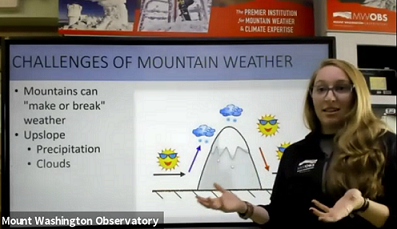Mount Washington Observatory’s Virtual Classroom “Home of the World’s Worst Weather Live”
2020-12-14 13:09:03.000 – Brian Fitzgerald, Director of Science and Education
With the end of the calendar year approaching, it’s a natural time to reflect on the past year and think of things to come. In the realm of educational programs at Mount Washington Observatory (MWO)- there’s a lot to reflect on. In this past year, a year with no equal, MWO was forced to suspend all in-person programs and figure out a way to uphold one significant part of MWO’s mission: develop and conduct innovative educational programs. One of the responses to this unprecedented challenge was to offer a free virtual classroom program called “Home of the World’s Worst Weather Live.”
Given the demand for relevant, high-quality and accessible virtual programs, it was prudent to take advantage of MWO’s already well-established distance learning programs and focus efforts on a free program that could reach as many classrooms as possible, no matter where they were (in-person, hybrid, remote, etc.). Weather Observer/Education Specialists Tom Padham and Ian Bailey got to work quickly, and by the first week of April Tom and Ian were conducting live programs three times a week from the summit, developing worksheets, sharing live weather conditions and forecasts and presenting mini “deep-dive” lessons on particular aspects of weather and climate on Mount Washington and beyond. Each week Tom and Ian covered topics such as severe thunderstorms or how individual weather variables are measured on the summit– always with an enthusiastic audience that enjoyed the opportunity to ask questions of the observers and hear their names and questions read aloud during the program.

Weather Observer/Education Specialist Nicole Tallman discusses some of the mountain-specific challenges of forecasting the weather at MWO during a virtual classroom program.
Following a summer hiatus that sadly saw the departure of both Tom and Ian, MWO was fortunate to see Nicole Tallman and Nate Iannuccillo come on board in the Weather Observer/Education Specialist role. With a chance to pause, gather feedback from the spring’s programs and contemplate how MWO could sustain programs not just for a month or two, but for the whole school year ahead, the education team decided to focus the virtual classroom even further to support middle school students as they traverse a number of topics within weather and climate. The Next Generation Science Standards served as a guide help build out the curriculum for the school year as well (see the screen shoot below). Programs moved from Facebook Live where they were previously held, and shifted to Zoom Webinar in order to provide even more flexibility, security and privacy protections to students no matter where they connected. Programs this Fall first took on topics in weather, where Nicole and Nate have so far covered everything from careers in meteorology, to global circulation patterns to weather prediction. As the year comes to end and winter weather reigns supreme in the mountains, Ice and Winter Precipitation will round out December.

As we look ahead to the new year and continuing to build our audience of classrooms and students (many of all ages), the virtual classroom program will tackle the Earth’s Climate System, and Climate Change. For many students at the middle school level, this is the first time that the concept of climate change is introduced and teachers have the all-important task of helping students understand the scientific underpinnings of how Earth’s climate system operates, and how significant inputs to the system like greenhouse gas pollution impact long-term climate and present-day weather. Critical to this understanding, is providing students with credible, and where possible, local sources of knowledge and evidence related to climate change.
Between myself, Nate and Nicole, we’re incredibly grateful to have the opportunity to connect with students and their teachers right now in this continued time of need. There’s a lot to look forward to this spring as MWO dives deeper into aspects of program development that we’ve never had the chance to explore while building relationships with classrooms that continue to participate week after week, or just pop in here or there for a program, or just share our recorded programs whenever they can. With the support of the Kendal C. and Anna Ham Charitable Foundation, MathWorks Inc., and members of MWO, we are fortunate to have the continued support that allows us to focus on the task ahead and further the reach and impact of this storied institution.
For more information about MWO’s Virtual Classroom, including how to sign up for a program or watched previous programs, visit www.mountwashington.org/classroom
Brian Fitzgerald, Director of Science and Education
Team Flags Return for Seek the Peak’s 25th Anniversary
Team Flags Return for Seek the Peak's 25th Anniversary By MWOBS Staff Mount Washington Observatory is looking forward to continuing a much-loved tradition for Seek the Peak’s 25th Anniversary: Team flags. In inviting teams
Meet Summer Interns Zakiya, Max and Maddie
Meet Summer Interns Zakiya, Max and Maddie By MWOBS Staff We are excited to welcome six teammates to the summit of Mount Washington this summer! During their internship, these students and graduates will play
Saying Goodbye to the Summit
Saying Goodbye to the Summit By Alexis George After an extraordinary last three years working as a Weather Observer and Meteorologist, I am excited to pursue a different career. As sad I as am




